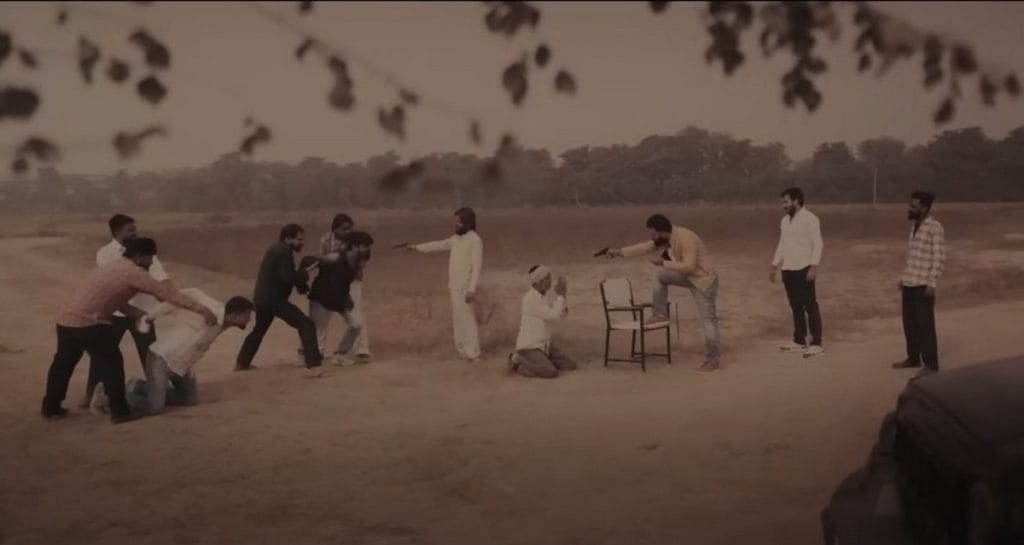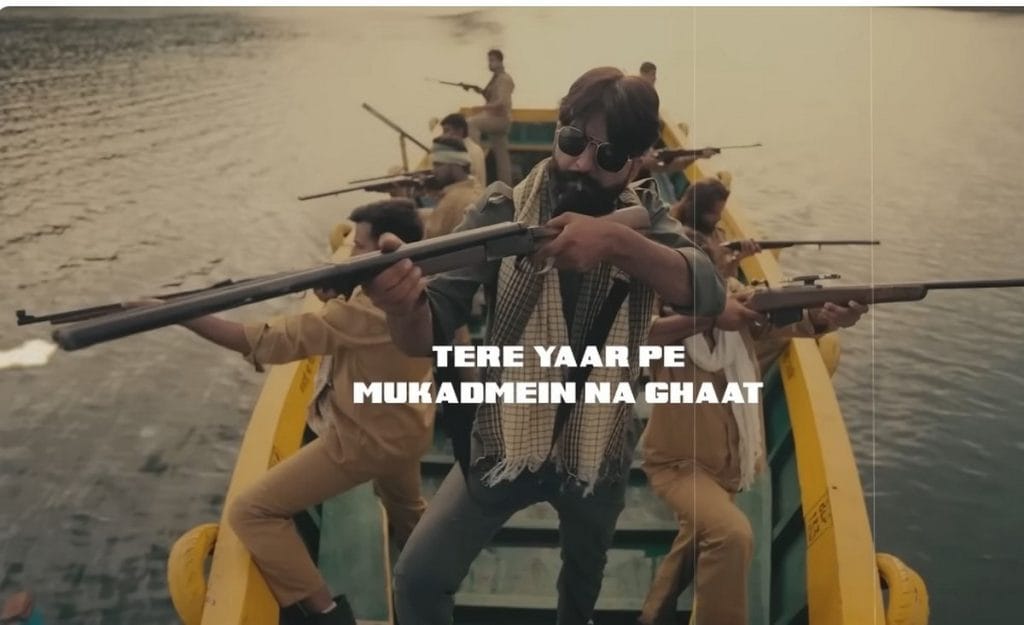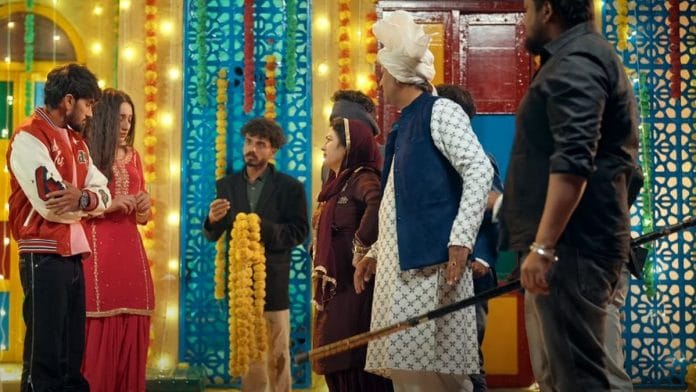New Delhi: Popular Haryanvi singer Masoom Sharma and director Chand Shivraj are struggling to deliver their usual dose of machismo in their upcoming music video. It was supposed to have men dancing and swinging guns to convey pride and power, but they’ve had to think twice and even considered using lathis instead. They are still not sure.
Rifles, romance, and rebellion have been standard ingredients for years in Nayi Haryanvi music, with slick productions and raw swagger giving Punjabi gangsta tracks a run for their money. Now, the Haryana government is cracking down on “anti-social” content in songs. The Haryana police has pulled down at least 18 songs from singers’ YouTube channels since March, of which 10 are by Sharma. These, including Tuition Badmaashi Ka (The Tuition of Gangsterism), 60 Mukadme (Sixty Cases), and Khuni Ranjis (Bloody Feud), had collectively gained over 100 million views on YouTube. The others include songs by Narendra Bhagana, Kay D, and Ankit Balian’s Bhari Court Mein Goli Maarange Meri Jaan.
The state government says the music promotes gun culture, hooliganism, and obscenity, and has warned more action is coming. But for the Haryanvi music industry, this is nothing short of an existential crisis. The songs in question haven’t been removed entirely from YouTube but they are no longer on singers’ channels. It’s cost them financially, since much of their revenue comes from views and ad streams on the platform. Directors and artists warn the crackdown is already damaging the industry. Some are now hesitant to release new songs for fear of them being taken down, others are rewriting lyrics or reshooting videos.
“No matter what the situation is, nowadays targeting artists has become a new trend,” said singer and lyricist Narendra Bhagana, whose popular songs Bhai Tera Gunda Sai and Tere Yaar Ki Bandook were taken down from his channel.
“It seems like artists no longer have freedom here. We can’t work or write freely.” He added that sudden takedowns like this, done without notice or clear rules, shake confidence and have a chilling effect.
“We are artists. We only try to produce and present what the audience wants and what society itself demands,” said film and music video director Chand Shivraj. “We will not go against the government, as it would only harm the artists — but we will also not stop our work.”
Social concern vs social demand
In 60 Mukadame, one of Masoom Sharma’s ‘banned’ videos, the guns are everywhere, but the song is essentially about a woman fed up with the lifestyle of her lover, a local gangster.
“Romantic-sa mila maine yaar. Bandook tanga handa aat mein” (I wanted a romantic lover. He roams around with a gun), sings co-vocalist Shivani Yadav in the song, which got over 8 million views on YouTube. “Oh, I made a mistake by becoming the daughter-in-law… Because in the nights, in their nights, a black car roams.”
Apart from flexing muscle, Haryanvi music also wrestles with social codes, from honour killings and love marriages to rebellion against family pressures. The weapons often serve as shorthand for danger, defiance, and a jab at the old order.

“When we create songs about love, romance, family, and other positive themes, they barely get any views. But our songs with bold, rebellious content get millions and even billions of views — that clearly shows what the audience wants,” said Shivraj, who has directed many of Sharma’s videos. In the absence of further action from the government, he added he’s thinking of going ahead with guns in future videos.
But backlash has been building for some time. Khap panchayats, the region’s self-appointed moral guardians, have been calling for a ban on songs they claim are leading Haryana’s youth astray. Several khaps in Jind and Rohtak have joined forces to demand action against music that promotes guns and “obscene” behaviour.
“The purpose of songs should be to strengthen our culture and entertain people, not to corrupt society or send a wrong message to future generations,” said Tekram Kandela, president of the Haryana Khap Panchayat. “The government shouldn’t just act on only some artists or songs — it should ban all songs that promote gun culture and vulgarity.”
Chief Minister Nayab Saini has said that the government would “consider” legislation against such songs “if necessary”.

“These songs influence our young generation toward crime and chaos,” he added at a press conference. “We cannot allow gun culture to take root in Haryana. Guns are not glory.”
However, some Opposition leaders as well as some ministers in the BJP government are not on board with a strict clampdown. Haryana Social Justice Minister Krishan Bedi said singers should be forgiven for their “mistakes” and simply made to promise they’ll avoid such content in future.
“These singers have done a lot for the pride of Haryana. Just four-five years ago, only Punjabi songs were played during wedding functions in the state,” Bedi said.
The crackdown has left the music industry divided as well. Some insiders support the move; others say it threatens a booming scene and is targeting only a few singers. Sharma has accused Gajender Phogat, a rival musician and the Officer on Special Duty (Publicity) to the Haryana CM, of a “conspiracy” against him, which Phogat has denied. Sharma also pointed out that if his songs were being removed so should one of Phogat’s, which has the line ‘Tadke pavei laas nahar mein (At dawn, the body will be found in the canal)’ .
Vikas Rajana, a prominent Haryanvi music producer who has worked with top artists like Masoom Sharma, Sapna Choudhary, Renuka Pawar, Amanraj Gill, and Raj Mawar, claimed the takedowns were politically motivated.
“The government and officials don’t have time to randomly select songs from emerging artists and delete them only from one’s YouTube channel. This has been done because of competition in the industry,” Rajana told ThePrint. “If the government is genuinely concerned about the growing gun culture, they should have started by deleting songs and movies from big production houses—not by targeting a few singers,”
What many are worried about is what this move means for the kadak (tough) identity of Nayi Haryanvi music.
“We are not promoting violence or telling people to pick up guns after listening to our songs and people are not doing that also. We are simply producing content that reflects what has always been a part of Haryana’s bold and fearless culture,” added Shivraj.
Also Read: Haryana has a bold, new film industry. It’s radical and not all jugaad
Lathis and losses
Usually booked solid, Shivraj now finds himself with a lot more free time. Earlier, he was constantly on set, directing one music video after another, but many projects are on hold. He has seven tracks ready, with the audio wrapped, is still figuring out how to shoot the videos without getting flagged. He’s also on the fence about some lyrics. The wrong call could cost him millions of views and major production money.
“The Haryana music industry is facing a pause. We can’t take any more risks, as we are already facing losses,” he said.
Already, the look and feel of Haryanvi videos seem to be changing.
‘Paanch Paanch Mere Bhai’, released in late April, tells the story of a couple sneaking around under the threat of an honour killing at the hands of the girl’s five brothers. “Paach-paanch mere bhai, honour killing ho jaati,” goes the refrain. The five men, however, carry lathis rather than guns. It’s tame by the genre’s usual standards.
“The Haryana music industry has gained immense popularity and growth over the last six to seven years, but the sudden bans and takedowns of songs are pulling it back again,” said Ashish Nehra, a film director from Haryana.
Shivraj pointed out that not every song features guns or depicts violence; it always depends on the demands of the script. He said the inclusion of guns is based on the lyrics and the context required by the storyline.
“Guns have always been a part of Haryanvi local folklore, symbolising power, pride, and protection. Our songs often reflect that reality,” said Shivraj.
For Shiva Jangra, a prominent singer, songwriter, and director in the Haryanvi music scene, the way forward is clear guidelines from the government. Without them, he says, artists are left guessing what will or won’t land them in trouble. Rules would help maintain standards and let the industry work without constant fear.
“It is better to follow the guidelines than to lose your money and hard work later,” said Jangra.
Also Read: Whose song is it anyway? What’s the controversy that has stalled release of Haryana’s Rajya Geet
‘It’s easy to target an artist’
Police halted Masoom Sharma mid-performance in Gurugram when he launched into Ek Khatola Jail Ke Bhitar (A cot in the jail) at a March concert, one of the banned tracks. Sharma then told the audience they were still allowed to sing it and when they did, he joined in. A video shows an ACP reaching up to snatch the mic from his hand.
While this kind of enforcement is new, it’s been years in the making. It traces back to a 2019 Punjab and Haryana High Court order directing police in Punjab, Haryana, and Chandigarh to act against celebratory firing and songs glorifying liquor, drugs, and violence. In 2025, a contempt petition was filed, alleging non-compliance. The court issued a notice to the authorities, asking them to enforce the order more strictly, including in the case of songs. Soon after, at a law-and-order meeting led by CM Saini, Haryana Police’s cyber wing was told to get to work.
“We have written to YouTube, citing the relevant high court order to remove certain video songs promoting gun culture. We will also legally focus on lyricists, producers, and directors of such songs in the future,” a senior police officer was quoted as saying in The Times of India.
The crackdown isn’t limited to Haryana, with even Punjabi singers like Diljit Dosanjh and Karan Aujla receiving notices over alcohol references in their songs and concerts. After a directive from the Telangana government prohibiting songs that promote alcohol, drugs, or violence during his concerts, Dosanjh tweaked lyrics mid-performance to avoid trouble at a Hyderabad show in November 2024. He changed “Tainu teri daaru ch pasand aa lemonade” (you like lemonade in your liquor) to “Tainu teri coke ch pasand aa lemonade” (you like lemonade in your Coke), and “5 taara thekke utthe” (at the five-star liquor shop) to “5 taara hotel ch” (in the five-star hotel).
For the artists in Haryana, meanwhile, frustration is mounting.
“If our positive work isn’t influencing society or teaching them anything, then how can they claim people are being influenced just by seeing guns in a music video?” asked Nehra.
Many in the industry say the strictures are limiting the creative lexicon Haryanvi artists have long relied on.
“We are working in society and for society. Songs and videos are created based on the needs of the script. Just as an action movie cannot work without action and fight scenes, similarly, a song video is shot according to its requirements,” said Bhagana.
Both Bhagana and Nehra pointed out that it’s not just the artist at stake, but many other producers, writers, instrumentalists, and technicians.
“It’s easy to target an artist and take down their work, but the government should think about the entire industry, which is also a part of society,” said Nehra.
(Edited by Asavari Singh)






